-
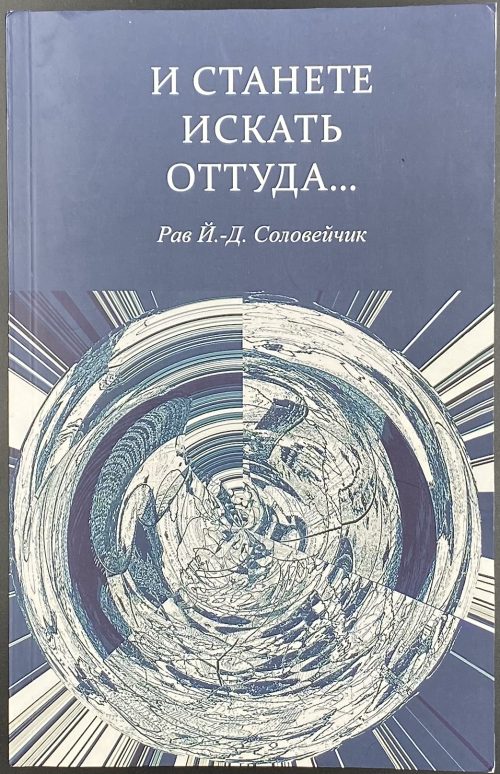 Paperback, 21.2 x 13.6 cm, dark blue pictorial covers with white lettering, pp.: [2] 3-316 [4]. Title-page: Рав. Й.-Д. Соловейчик | И СТАНЕТЕ ИСКАТЬ | ОТТУДА… | Перевод Мириам Китросской | Памяти | Миши Шнейдера и Лены Гальпериной | {publisher’s device} | Иерусалим 5782 (2022) || Contributors: Иосеф Дов-Бер ха-Леви Соловейчик [יוסף דב הלוי סולובייצ'יק, Joseph Dov-Ber Soloveitchik) (Jewish-American, 1903 – 1993) Мириам Китросская [Miriam Kitrossky] (Israeli, b. 1957)
Paperback, 21.2 x 13.6 cm, dark blue pictorial covers with white lettering, pp.: [2] 3-316 [4]. Title-page: Рав. Й.-Д. Соловейчик | И СТАНЕТЕ ИСКАТЬ | ОТТУДА… | Перевод Мириам Китросской | Памяти | Миши Шнейдера и Лены Гальпериной | {publisher’s device} | Иерусалим 5782 (2022) || Contributors: Иосеф Дов-Бер ха-Леви Соловейчик [יוסף דב הלוי סולובייצ'יק, Joseph Dov-Ber Soloveitchik) (Jewish-American, 1903 – 1993) Мириам Китросская [Miriam Kitrossky] (Israeli, b. 1957) -
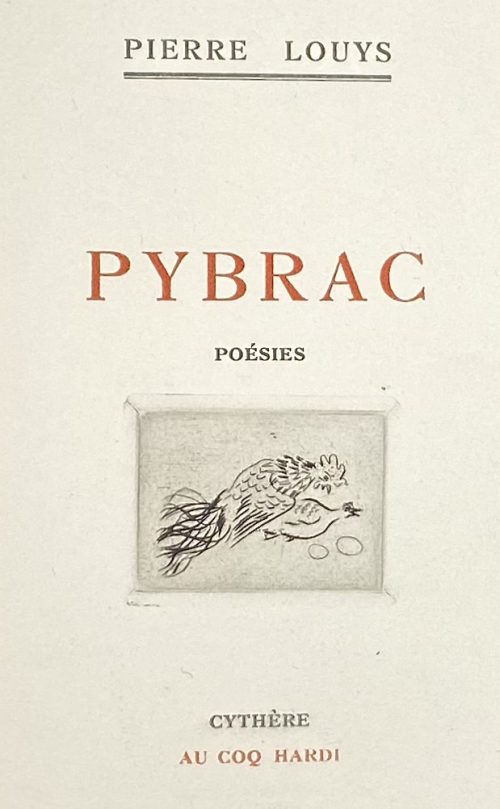 Description: Softcover, French flapped wrappers, 19.7 x 14.5 cm, printed on thick wove paper watermarked “J. PERRIGOT ARCHES MBM”; engraved vignette by Foujita to t.p.; some pages towards the end uncut. Illustrated by ten original watercolours, unsigned. Collation: Pink wrappers, lettered to front, in frame: “P. L. |—| PYBRAC |—| 1927”, 2 blank leaves (one in wrapper), [2] h.t./blank, [2] t.p. in red and black with engraved vignette by Foujita / blank, [2] (Sur la chemise...), [2] f.t. / watercolour on reverse, [5] 6-98 [2 colophon/blank], 2 blank leaves (one in wrapper). Title-page (red and black): PIERRE LOUŸS | PYBRAC | POESIES | {vignette} | CYTHÈRE | AU COQ HARDI || Edition: Limited edition of 105 copies, of which this is copy № 28 on Arches paper, unique as enhanced with 10 colour drawings by an anonymous artist, presumably by Feodor Rojankovsky (dit Rojan), a unique copy. Cat. raisonné: Dutel III № 2278 p. 334; Dutel describes two unique copies of the edition, one with 6 and another with 24 original watercolours by Rojan. Contributors: Pierre Louÿs (French, 1870 – 1925) – author. Léonard Tsuguharu Foujita (Japanese-French, 1886 – 1968) – artist (t.p. vignette). Feodor Rojankovsky [Rojan, Фёдор Степанович Рожанковский] (Russian-American, 1891 – 1970). René Bonnel (French, 1884 – 1975) – publisher. Another unique copy of the same edition illustrated by an anonymous artist in this collection LIB-3061.2022.
Description: Softcover, French flapped wrappers, 19.7 x 14.5 cm, printed on thick wove paper watermarked “J. PERRIGOT ARCHES MBM”; engraved vignette by Foujita to t.p.; some pages towards the end uncut. Illustrated by ten original watercolours, unsigned. Collation: Pink wrappers, lettered to front, in frame: “P. L. |—| PYBRAC |—| 1927”, 2 blank leaves (one in wrapper), [2] h.t./blank, [2] t.p. in red and black with engraved vignette by Foujita / blank, [2] (Sur la chemise...), [2] f.t. / watercolour on reverse, [5] 6-98 [2 colophon/blank], 2 blank leaves (one in wrapper). Title-page (red and black): PIERRE LOUŸS | PYBRAC | POESIES | {vignette} | CYTHÈRE | AU COQ HARDI || Edition: Limited edition of 105 copies, of which this is copy № 28 on Arches paper, unique as enhanced with 10 colour drawings by an anonymous artist, presumably by Feodor Rojankovsky (dit Rojan), a unique copy. Cat. raisonné: Dutel III № 2278 p. 334; Dutel describes two unique copies of the edition, one with 6 and another with 24 original watercolours by Rojan. Contributors: Pierre Louÿs (French, 1870 – 1925) – author. Léonard Tsuguharu Foujita (Japanese-French, 1886 – 1968) – artist (t.p. vignette). Feodor Rojankovsky [Rojan, Фёдор Степанович Рожанковский] (Russian-American, 1891 – 1970). René Bonnel (French, 1884 – 1975) – publisher. Another unique copy of the same edition illustrated by an anonymous artist in this collection LIB-3061.2022. -
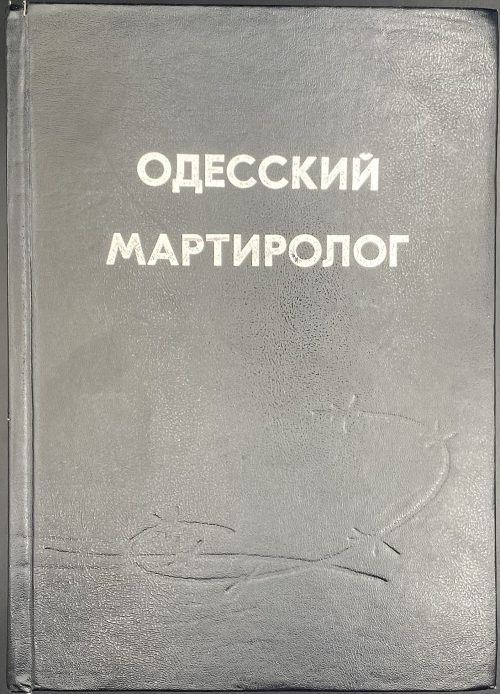 Hardcover volume, 24.5 x 17.5 cm, bound in black buckram with blind barbed wire design and silver lettering to front cover and spine, pp.: [2] 3-799 [800]. Одеський мартиролог: Данi про репресованих Одеси i Одеськоï областi за роки радянськоï влады (Серiя «Реабiлiтованi iсторiэю») (Том 2) / Уклад.: Л. В. Ковальчук, Г. О. Разумов— Одеса : ОКФА, 1999. Title-page: Научно-документальная серия книг | «РЕАБИЛИТИРОВАННЫЕ ИСТОРИЕЙ» | ОДЕССКИЙ | МАРТИРОЛОГ | ТОМ 2 | Одесса | ОКФА | 1999 || ISBN: 966-571-035-4 Print run: 1,000 copies. Ковальчук, Лидия Всеволодовна Разумов, Георгий Александрович
Hardcover volume, 24.5 x 17.5 cm, bound in black buckram with blind barbed wire design and silver lettering to front cover and spine, pp.: [2] 3-799 [800]. Одеський мартиролог: Данi про репресованих Одеси i Одеськоï областi за роки радянськоï влады (Серiя «Реабiлiтованi iсторiэю») (Том 2) / Уклад.: Л. В. Ковальчук, Г. О. Разумов— Одеса : ОКФА, 1999. Title-page: Научно-документальная серия книг | «РЕАБИЛИТИРОВАННЫЕ ИСТОРИЕЙ» | ОДЕССКИЙ | МАРТИРОЛОГ | ТОМ 2 | Одесса | ОКФА | 1999 || ISBN: 966-571-035-4 Print run: 1,000 copies. Ковальчук, Лидия Всеволодовна Разумов, Георгий АлександровичPages 515-531. 13. Постановление помощника уполномоченного Одесского окружного отдела ГПУ Найдмана по делу сотрудников Индо-Европейского телеграфа, репрессированных в 1927 г. по обвинению в шпионаже. […] ВАРШАВСКОЙ Эльзы Филипповны, 45 лет, уроженицы г. Одессы, по национальности – еврейка, происходит из купеческой семьи, подданства УССР, образования среднего, замужняя, не судившаяся, беспартийная, в союзе не состоит, без профессии, проживавшая по ул. Хмельницкого в д. № 18, в совершении преступлений, предусмотренных ст. 54-6 УК УССР, нашел: […] Note: ст. 54-6 — шпигунство: позбавлення волі на строк не менш як 3 роки, з конфіскацією всього або частини майна, аж до вищого заходу соціального захисту — розстрілу.
-
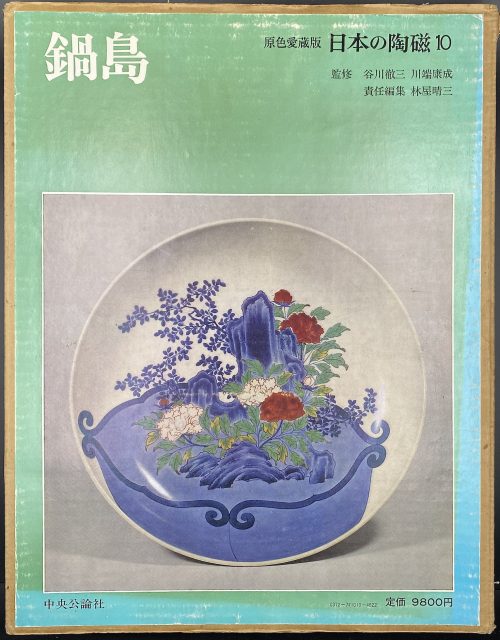 Hardcover volume, 35 x 26.8 cm, bound in grey cloth, blind stamped characters to front, brown characters to spine, in a double slipcase, the outer case pictorial paper over cardboard, 36 x 28.2 cm, pp.: [4] [1] 2-144 (plates with photographs of 332 items), [2] 147-182 [4]. 鍋島 – Nabeshima – book title. 日本の陶磁 – Japanese ceramics, series title. Contributors: Yasunari Kawabata [川端 康成] (Japanese, 1924 – 1972) – author. Tetsuzo Tanikawa [谷川 徹三] (Japanese, 1895 – 1989) – author. Seizo Hayashiya [林屋晴三] (Japanese, 1928 – 2017) – editor. Chūōkōron-sha [中央公論社] – publisher.
Hardcover volume, 35 x 26.8 cm, bound in grey cloth, blind stamped characters to front, brown characters to spine, in a double slipcase, the outer case pictorial paper over cardboard, 36 x 28.2 cm, pp.: [4] [1] 2-144 (plates with photographs of 332 items), [2] 147-182 [4]. 鍋島 – Nabeshima – book title. 日本の陶磁 – Japanese ceramics, series title. Contributors: Yasunari Kawabata [川端 康成] (Japanese, 1924 – 1972) – author. Tetsuzo Tanikawa [谷川 徹三] (Japanese, 1895 – 1989) – author. Seizo Hayashiya [林屋晴三] (Japanese, 1928 – 2017) – editor. Chūōkōron-sha [中央公論社] – publisher. -
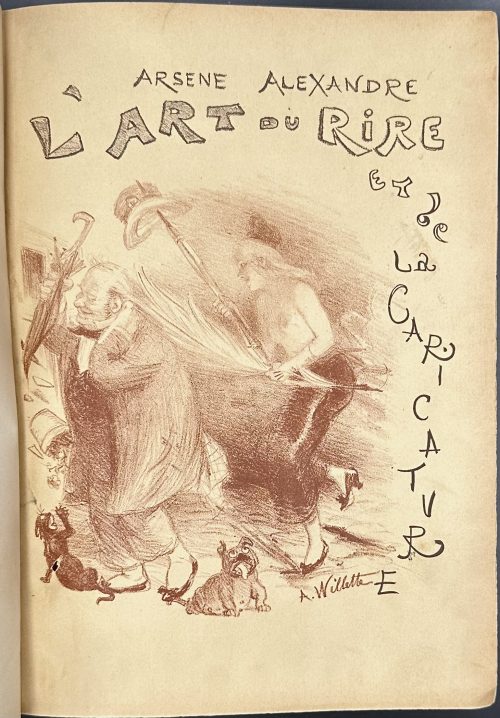 Hardcover volume 28.5 x 20.8 cm, quarter brown morocco over marbled boards, ruled in gilt, spine with raised bands, gilt in compartments, gilt lettering, marbled endpapers, top margin gilt, original lithographic wrappers designed by A. Willette preserved; pp.: [4] h.t., t.p., [1] 2-350 [2], 300 b/w ils in-text and 12 coloured photomechanical reproductions extraneous to collation; collated in-4o: π2 1-444; Title-page: L'ART DU RIRE | ET DE | LA CARICATURE | PAR ARSÈNE ALEXANDRE | 300 FAC-SIMILÉS EN NOIR ET 12 PLANCHES EN COULEURS | D’APRÈS LES ORIGINAUX | {vignette} | PARIS | ANCIENNE MAISON QUANIN | LIBRAIRIES-IMPRIMERIES RÉUNIES | 7, RUE ST-BENOIT | MAY & MOTTEROZ, DIRECTEURS || Contributors : Librairie-Imprimerie réunies (Paris, 1880-1908) – publisher. Arsène Alexandre (French, 1859 – 1937) – author. Adolphe Willette (French, 1857 – 1926) – artist (wrapper)
Hardcover volume 28.5 x 20.8 cm, quarter brown morocco over marbled boards, ruled in gilt, spine with raised bands, gilt in compartments, gilt lettering, marbled endpapers, top margin gilt, original lithographic wrappers designed by A. Willette preserved; pp.: [4] h.t., t.p., [1] 2-350 [2], 300 b/w ils in-text and 12 coloured photomechanical reproductions extraneous to collation; collated in-4o: π2 1-444; Title-page: L'ART DU RIRE | ET DE | LA CARICATURE | PAR ARSÈNE ALEXANDRE | 300 FAC-SIMILÉS EN NOIR ET 12 PLANCHES EN COULEURS | D’APRÈS LES ORIGINAUX | {vignette} | PARIS | ANCIENNE MAISON QUANIN | LIBRAIRIES-IMPRIMERIES RÉUNIES | 7, RUE ST-BENOIT | MAY & MOTTEROZ, DIRECTEURS || Contributors : Librairie-Imprimerie réunies (Paris, 1880-1908) – publisher. Arsène Alexandre (French, 1859 – 1937) – author. Adolphe Willette (French, 1857 – 1926) – artist (wrapper) -
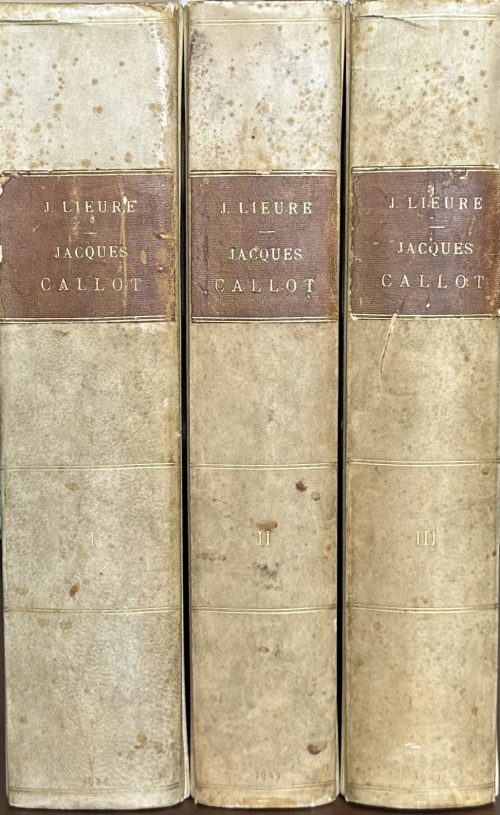 Three volumes, 33 x 26.5 x 7 cm each, uniformly bound in 2/3 vellum over marbled boards, outlined with gilt fillet, brown label with gilt lettering to flat spine with double fillet faux-bands, marbled endpapers, top edge gilt, other untrimmed, publisher’s wrappers preserved, incl. spine; collotype plates with captioned glassine guards; armorial bookplate of Comte Alain de Suzannet to front pastedown in each volume. Two volumes of Première partie, wanting, contain La vie artistique : texte and La vie artistique : planches. Title-page (red and black): JACQUES CALLOT | PAR | J. LIEURE | Introduction de F. Courboin | Conservateur du Cabinet des Estampes à la Bibliothèque Nationale | — | DEUXIÈME PARTIE | CATALOGUE DE L’ŒUVRE GRAVÉ | TOME I (II, III) | — | PARIS | ÉDITIONS DE LA GAZETTE DES BEAUX-ARTS | 106, Boulevard Saint-Germain (6e) | 1924 (1927, 1927) || Vol. 1 (1924): [4] [1] 2-122 [2], wrappers, plates 1-299; printed on September 15, 1924, by André Lesot (Nemours) and D. Jacomet et Cie (Paris). Vol. 2 (1927): [4] [1] 2-106 [2], wrappers, plates 300-652. Vol. 3 (1927): [4] [1] 2-128 [4], wrappers, plates 653-1428; printed on September 5, 1926, by Imprimerie moderne des Beaux-Arts (Bois-Colombes) and D. Jacomet et Cie (Paris). Contributors: Jules Lieure (French, 1866 – 1948) – author. Jacques Callot (French, c. 1592 – 1635) – artist. Gazette des Beaux-Arts (f. 1859) – publisher. François Courboin (French, 1865 – 1926) – author. D. Jacomet et Cie (Paris) – printer. Daniel Jacomet (French, 1894 – 1966) – printer. André Lesot (French, 1874-1951) – printer. Imprimerie moderne des Beaux-Arts (Bois-Colombes) Comte Alain de Suzannet (French, 1882 – 1950) – provenance.
Three volumes, 33 x 26.5 x 7 cm each, uniformly bound in 2/3 vellum over marbled boards, outlined with gilt fillet, brown label with gilt lettering to flat spine with double fillet faux-bands, marbled endpapers, top edge gilt, other untrimmed, publisher’s wrappers preserved, incl. spine; collotype plates with captioned glassine guards; armorial bookplate of Comte Alain de Suzannet to front pastedown in each volume. Two volumes of Première partie, wanting, contain La vie artistique : texte and La vie artistique : planches. Title-page (red and black): JACQUES CALLOT | PAR | J. LIEURE | Introduction de F. Courboin | Conservateur du Cabinet des Estampes à la Bibliothèque Nationale | — | DEUXIÈME PARTIE | CATALOGUE DE L’ŒUVRE GRAVÉ | TOME I (II, III) | — | PARIS | ÉDITIONS DE LA GAZETTE DES BEAUX-ARTS | 106, Boulevard Saint-Germain (6e) | 1924 (1927, 1927) || Vol. 1 (1924): [4] [1] 2-122 [2], wrappers, plates 1-299; printed on September 15, 1924, by André Lesot (Nemours) and D. Jacomet et Cie (Paris). Vol. 2 (1927): [4] [1] 2-106 [2], wrappers, plates 300-652. Vol. 3 (1927): [4] [1] 2-128 [4], wrappers, plates 653-1428; printed on September 5, 1926, by Imprimerie moderne des Beaux-Arts (Bois-Colombes) and D. Jacomet et Cie (Paris). Contributors: Jules Lieure (French, 1866 – 1948) – author. Jacques Callot (French, c. 1592 – 1635) – artist. Gazette des Beaux-Arts (f. 1859) – publisher. François Courboin (French, 1865 – 1926) – author. D. Jacomet et Cie (Paris) – printer. Daniel Jacomet (French, 1894 – 1966) – printer. André Lesot (French, 1874-1951) – printer. Imprimerie moderne des Beaux-Arts (Bois-Colombes) Comte Alain de Suzannet (French, 1882 – 1950) – provenance. -
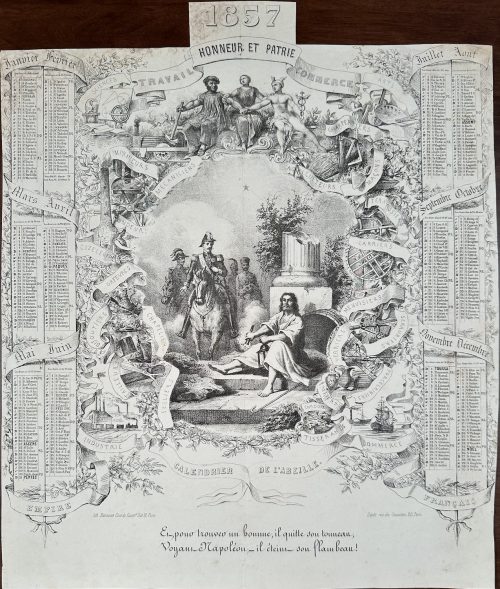 Lithography and etching on wove paper432 x 362 mm, black ink stamp “5022” to reverse, horizontal and vertical centrefolds. Depicts Diogenes (Ancient Greek, 412/404 – 323 BC) beside his barrel and extinguishing his torch when approached by Napoléon III ahorseback. Top: "1857 | HONNEUR ET PATRIE"; lettering on ribbons (top-down): SCIENCES, TRAVAIL, COMMERCE, ARTS, CHARPENTIERS, IMPRIMEURS, "MECHANICIENS, AGRICULTEURS, MAÇONS, FONDEURS, TERRASIERS, CIZELEURS, CARRIERS, ORFEVRES, BIJOUTIERS, CHAPELIERS, MENUISIERS, VERRIERS, SERRURIERS, TAILLEURS, SELLIERS, POTIERS, PORCELAINIERS, CORDONNIERS, TISSERANDS, INDUSTRIE, COMMERCE | CALENDRIER DE L'ABEILLE | EMPIRE, FRANÇAIS. Below left: "lith. Barousse Cour du Comm. 11 et 12. Paris"; right: "Dépôt rue des Cannettes, 20. Paris"; bottom: "Et, pour trouver un homme, il quitte son tonneau, | Voyant Napoléon, – il éteint son flambeau!" [And, to find a man, he leaves his barrel, | Seeing Napoleon, – he extinguishes his torch!]. Six months on the left and six months on the right-hand side of the calendar, surrounding the image.
Lithography and etching on wove paper432 x 362 mm, black ink stamp “5022” to reverse, horizontal and vertical centrefolds. Depicts Diogenes (Ancient Greek, 412/404 – 323 BC) beside his barrel and extinguishing his torch when approached by Napoléon III ahorseback. Top: "1857 | HONNEUR ET PATRIE"; lettering on ribbons (top-down): SCIENCES, TRAVAIL, COMMERCE, ARTS, CHARPENTIERS, IMPRIMEURS, "MECHANICIENS, AGRICULTEURS, MAÇONS, FONDEURS, TERRASIERS, CIZELEURS, CARRIERS, ORFEVRES, BIJOUTIERS, CHAPELIERS, MENUISIERS, VERRIERS, SERRURIERS, TAILLEURS, SELLIERS, POTIERS, PORCELAINIERS, CORDONNIERS, TISSERANDS, INDUSTRIE, COMMERCE | CALENDRIER DE L'ABEILLE | EMPIRE, FRANÇAIS. Below left: "lith. Barousse Cour du Comm. 11 et 12. Paris"; right: "Dépôt rue des Cannettes, 20. Paris"; bottom: "Et, pour trouver un homme, il quitte son tonneau, | Voyant Napoléon, – il éteint son flambeau!" [And, to find a man, he leaves his barrel, | Seeing Napoleon, – he extinguishes his torch!]. Six months on the left and six months on the right-hand side of the calendar, surrounding the image. -
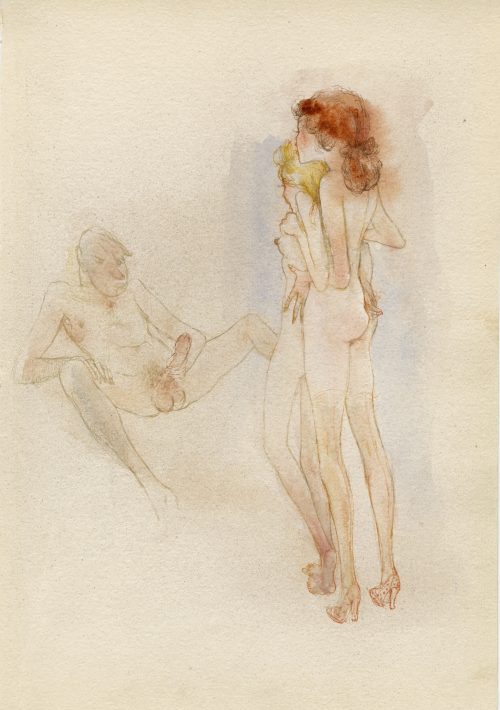 Watercolour on thick wove paper, unsigned. Attributed to Otto Rudolf Schatz (Austrian, 1900 – 1961). Size: 305 x 212 mm.
Watercolour on thick wove paper, unsigned. Attributed to Otto Rudolf Schatz (Austrian, 1900 – 1961). Size: 305 x 212 mm. -
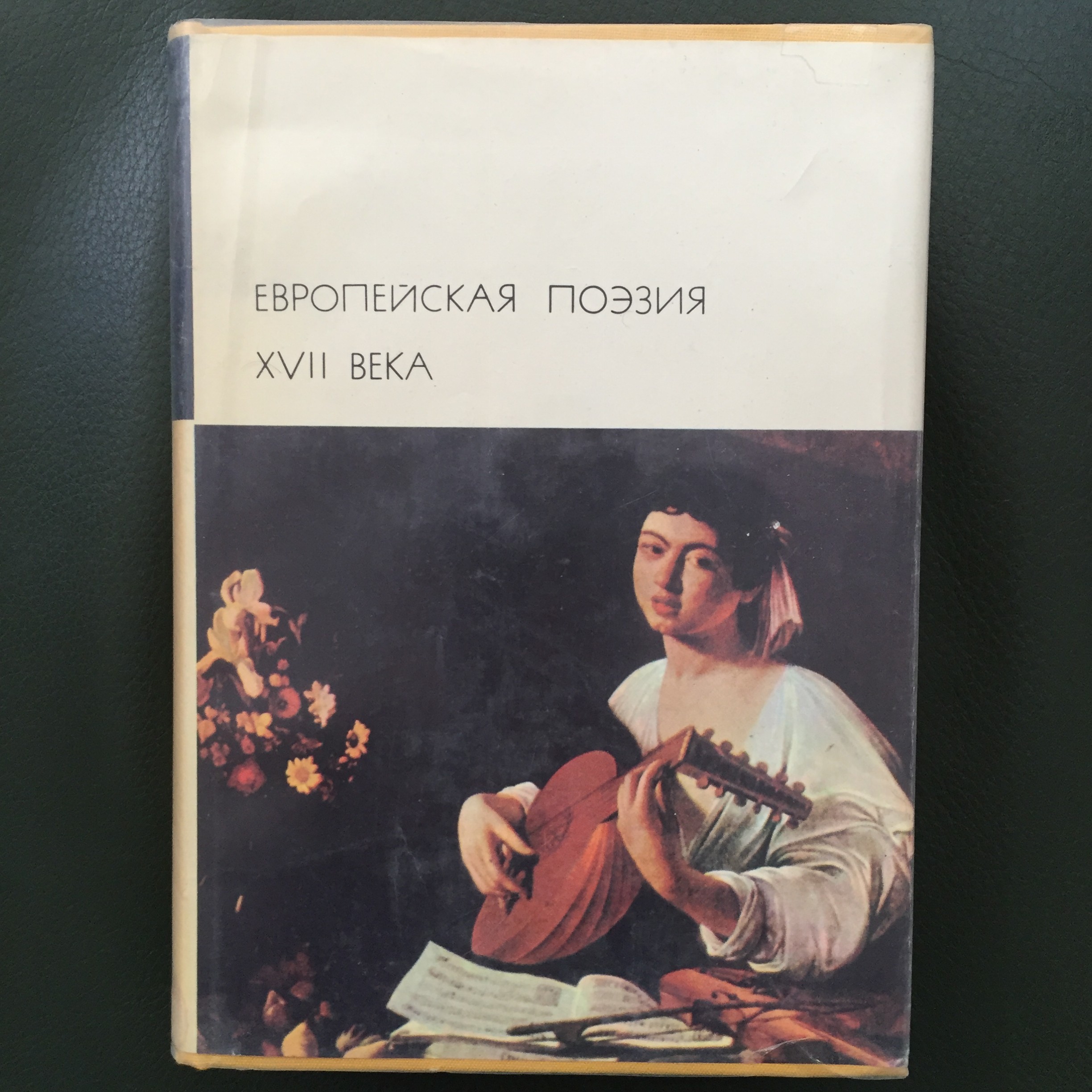
Европейская поэзия XVII века. Библиотека всемирной литературы. Серия первая. М.: Художественная литература, 1977. 928 с. Вступительная статья Ю. Виппера. Тир. 303 000.
-
 Seiro ehon nenju gyoji 青楼絵本年中行事 (A Picture Book of Annual Events in Yoshiwara). Block cut by: Fuji Kazumune (藤一宗). Printed by: Jakushodo Toemon (霍松堂藤右衛門). Written by: Jippensha Ikku (十返舎一九) (text, kyoka 4 & 12). Published by: Kazusaya Chusuke (上総屋忠助). Print artist: Kitagawa Utamaro (喜多川歌麿). Written by: Sandara Boshi (三陀羅法師) (kyoka 1). Workshop of: Yashiki no Katamaru (屋職堅丸). 1804 (spring); Edo. Reference: British Museum; Fine Arts Museums of San Francisco.
Seiro ehon nenju gyoji 青楼絵本年中行事 (A Picture Book of Annual Events in Yoshiwara). Block cut by: Fuji Kazumune (藤一宗). Printed by: Jakushodo Toemon (霍松堂藤右衛門). Written by: Jippensha Ikku (十返舎一九) (text, kyoka 4 & 12). Published by: Kazusaya Chusuke (上総屋忠助). Print artist: Kitagawa Utamaro (喜多川歌麿). Written by: Sandara Boshi (三陀羅法師) (kyoka 1). Workshop of: Yashiki no Katamaru (屋職堅丸). 1804 (spring); Edo. Reference: British Museum; Fine Arts Museums of San Francisco. -
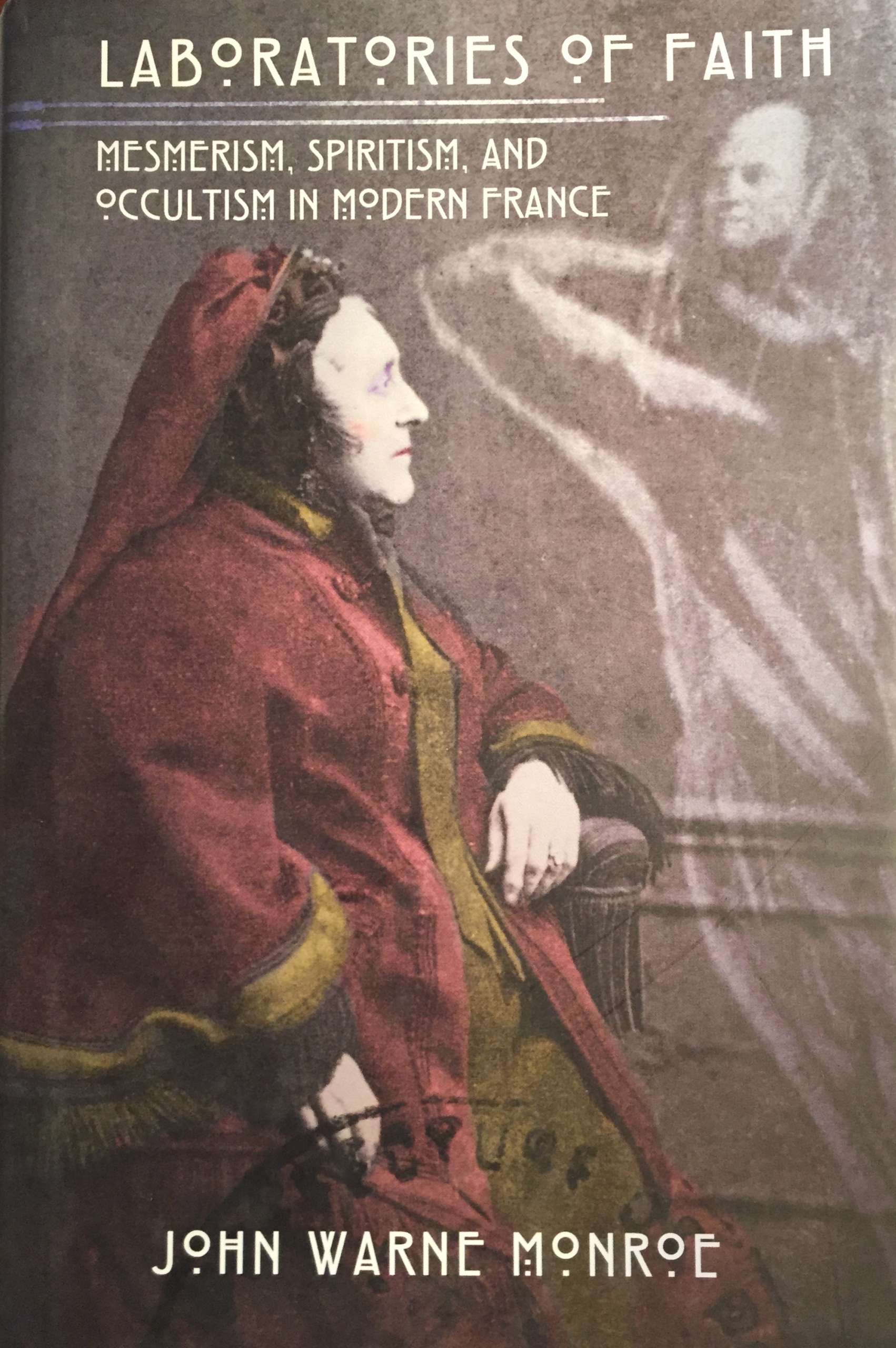
John Warne Monroe. Laboratories of Faith: Mesmerism, Spiritism, and Occultism in Modern France.
Cornel University Press, 2008.
ISBN: 9780801445620; Hardcover.
-
 Iron tsuba of round form with design of slanting rays of light (shakoh) or clock gear (tokei) in openwork (sukashi). Commonly considered a Christian / Jesuit motif. Round-cornered rim. Copper sekigane. Momoyama period: Late 16th century (Tensho/Keicho era). Height: 72.5 mm, Width: 72.2 mm, Rim thickness: 5.5 mm, Center thickness: 5.3 mm. Round-cornered rim. Provenance: Sasano collection. Sasano Masayuki, Japanese Sword Guards Masterpieces from The Sasano Collection, Part I, № 136: "The general belief that this design represents the gear of a clock is erroneous, rather it shows the slanting rays of light from a cross, with the small diamond shapes representing the upright and transverse bars. The Christian influence is obvious..."
Iron tsuba of round form with design of slanting rays of light (shakoh) or clock gear (tokei) in openwork (sukashi). Commonly considered a Christian / Jesuit motif. Round-cornered rim. Copper sekigane. Momoyama period: Late 16th century (Tensho/Keicho era). Height: 72.5 mm, Width: 72.2 mm, Rim thickness: 5.5 mm, Center thickness: 5.3 mm. Round-cornered rim. Provenance: Sasano collection. Sasano Masayuki, Japanese Sword Guards Masterpieces from The Sasano Collection, Part I, № 136: "The general belief that this design represents the gear of a clock is erroneous, rather it shows the slanting rays of light from a cross, with the small diamond shapes representing the upright and transverse bars. The Christian influence is obvious..." -
 Woodblock print album of thirteen prints, ōban, nishiki-e. Artist: Chōkyōsai Eiri [鳥橋斎 栄里] (Japanese, fl. c. 1789 ~ 1801 ). Models of calligraphy (Fumi no kiyogaki), New Year 1801. This title is taken from Chris Uhlenbeck's Japanese Erotic Fantasies Sexual Imagery of the Edo Period. — Hotei Publishing, 2005, ISBN 90-74822-66-5):. A detailed description of the album can be found at The Complete Ukiyo-e Shunga №9 Eiri, 1996, ISBN 4-309-91019. Most of the edition is in Japanese, though Richard Lane writes a section in English: Eiri: Love-letters, Love Consummated: Fumi-no-kiyogaki. The article starts with the following statement: "Why all the fuss about Sharaku? Because he is so "mysterious"? No, not at all: because he is such a good artist. But Sharaku is not the only great yet enigmatic ukiyo-e artist and I propose to resurrect here one of his important contemporaries who has been all too long neglected: Chōkyōsai Eiri. As with many of the notable ukiyo-e masters, nothing is known of Eiri's biography. All we can say is what we learn from his extant prints and paintings: that he flourished during the second half of the Kansei Period [1789-1801]; and that he was a direct pupil of the great Eishi - who, being of eminent samurai stock, may well have attracted pupils of similar background." Another citation from Japanese Erotic Fantasies: "This album is one of the boldest sets of ōban-size shunga known, The first edition contains thirteen instead of the customary twelve designs". Here I present all thirteen prints, though the edition I bought in Kyoto in 2014 contained only twelve. The thirteenth print was purchased later in the United States (sheet №12).
Woodblock print album of thirteen prints, ōban, nishiki-e. Artist: Chōkyōsai Eiri [鳥橋斎 栄里] (Japanese, fl. c. 1789 ~ 1801 ). Models of calligraphy (Fumi no kiyogaki), New Year 1801. This title is taken from Chris Uhlenbeck's Japanese Erotic Fantasies Sexual Imagery of the Edo Period. — Hotei Publishing, 2005, ISBN 90-74822-66-5):. A detailed description of the album can be found at The Complete Ukiyo-e Shunga №9 Eiri, 1996, ISBN 4-309-91019. Most of the edition is in Japanese, though Richard Lane writes a section in English: Eiri: Love-letters, Love Consummated: Fumi-no-kiyogaki. The article starts with the following statement: "Why all the fuss about Sharaku? Because he is so "mysterious"? No, not at all: because he is such a good artist. But Sharaku is not the only great yet enigmatic ukiyo-e artist and I propose to resurrect here one of his important contemporaries who has been all too long neglected: Chōkyōsai Eiri. As with many of the notable ukiyo-e masters, nothing is known of Eiri's biography. All we can say is what we learn from his extant prints and paintings: that he flourished during the second half of the Kansei Period [1789-1801]; and that he was a direct pupil of the great Eishi - who, being of eminent samurai stock, may well have attracted pupils of similar background." Another citation from Japanese Erotic Fantasies: "This album is one of the boldest sets of ōban-size shunga known, The first edition contains thirteen instead of the customary twelve designs". Here I present all thirteen prints, though the edition I bought in Kyoto in 2014 contained only twelve. The thirteenth print was purchased later in the United States (sheet №12). №1: "...one of the most exotic scenes in all shunga. A Dutch kapitan is discovered coupling with a lovely Japanese courtesan, beside a large window opening upon a garden...".
№1: "...one of the most exotic scenes in all shunga. A Dutch kapitan is discovered coupling with a lovely Japanese courtesan, beside a large window opening upon a garden...".

 №2: "...a fair young harlot is seen masturbating with a grinding-pestle - a man watches intently from under bedding." [I have two specimens of this design; the one from album is more soiled but less faded].
№2: "...a fair young harlot is seen masturbating with a grinding-pestle - a man watches intently from under bedding." [I have two specimens of this design; the one from album is more soiled but less faded].
 №3: "...the artist has effectively contrasted the lovers by depicting the man's face as seen through the geisha's gauze skirt. [...] we are impressed more by strikingly elegant composition, the dramatic coloring, rather than feeling any great urge to participate in the energetic proceedings..."
№3: "...the artist has effectively contrasted the lovers by depicting the man's face as seen through the geisha's gauze skirt. [...] we are impressed more by strikingly elegant composition, the dramatic coloring, rather than feeling any great urge to participate in the energetic proceedings..."
 №4: "This scene is a most straightforward one, featuring the standard Missionary Position [capitalization by R. Lane].; but withal, the contrast of the young and naked, secret lover and the richly-clothed courtesan amid luxurious bedding..."
№4: "This scene is a most straightforward one, featuring the standard Missionary Position [capitalization by R. Lane].; but withal, the contrast of the young and naked, secret lover and the richly-clothed courtesan amid luxurious bedding..."
 №5: "In a striking lesbian scene (which has no equivalent in Utamaro, and is, incidentally, often omitted in later editions of this album), the girl at left prepares to receive the harikata (dildo) worn by the older girl at right (who holds a seashell containing lubricant)."
№5: "In a striking lesbian scene (which has no equivalent in Utamaro, and is, incidentally, often omitted in later editions of this album), the girl at left prepares to receive the harikata (dildo) worn by the older girl at right (who holds a seashell containing lubricant)."
 №6: "In the first appearance of a matronly heroine in this series, we find a widow - with shaven eyebrows and clipped hair - sporting with a handsome yound shop-clerk, mounting him with all her might."
№6: "In the first appearance of a matronly heroine in this series, we find a widow - with shaven eyebrows and clipped hair - sporting with a handsome yound shop-clerk, mounting him with all her might."

 №7: "... lady of samurai court: here, shown taking advantage of an official outing to temple and theatre, to rendezvous with a secret lover on a teahouse balcony." R. Lane considers this design the least successful in the series, especially in comparison with the same theme by Utamaro: "Utamaro female is almost ferocious in her lust for sexual gratification", which does not sound true to me. See Utamaro's sheet №5 from the album Utamakura (歌まくら, Poem of the Pillow) [courtesy The British Museum without permission]:
№7: "... lady of samurai court: here, shown taking advantage of an official outing to temple and theatre, to rendezvous with a secret lover on a teahouse balcony." R. Lane considers this design the least successful in the series, especially in comparison with the same theme by Utamaro: "Utamaro female is almost ferocious in her lust for sexual gratification", which does not sound true to me. See Utamaro's sheet №5 from the album Utamakura (歌まくら, Poem of the Pillow) [courtesy The British Museum without permission]:
 Then, as Richard Lane states, "we are flung suddenly to the bottom rung of Edo society":
Then, as Richard Lane states, "we are flung suddenly to the bottom rung of Edo society":
 №8: "Here we find a fair yotaka ('night-hawk', e.i. streetwalker) accommodating a lusty client in a lumberyard by the bank of the Sumida River".
№8: "Here we find a fair yotaka ('night-hawk', e.i. streetwalker) accommodating a lusty client in a lumberyard by the bank of the Sumida River".
 №9: '... a slightly plump harlot of the lower class receives a night visit from her lover, whose naked form she tries to cover with a cloak."
№9: '... a slightly plump harlot of the lower class receives a night visit from her lover, whose naked form she tries to cover with a cloak."
 №10: "...likely maidservant and lackey - are depicted in bath-room, their passions are all too obviously fired by steaming water."
№10: "...likely maidservant and lackey - are depicted in bath-room, their passions are all too obviously fired by steaming water."
 №11: "...this scene of courtesan and secret lover ranks high not only in Eiri's œuvre but also in the annals of the ukiyo-e genre itself. Both design and colouring are impeccable and, for this period, there is nothing even in the work of great Utamaro that really surpasses it." Again, a doubtful statement, however, this is Utamaro's design for the reader to judge:
№11: "...this scene of courtesan and secret lover ranks high not only in Eiri's œuvre but also in the annals of the ukiyo-e genre itself. Both design and colouring are impeccable and, for this period, there is nothing even in the work of great Utamaro that really surpasses it." Again, a doubtful statement, however, this is Utamaro's design for the reader to judge:
 The last design in my album is this:
The last design in my album is this:
 #13: In most reference books it goes under number 13, and we will assign this number to the sheet. "The final scene of the album features naked participants, probably samurai man and wife. The print is rather subdued in tone and colour, if not in the degree of the passion displayed..."
An additional sheet, acquired separately from a reputable dealer in New York, is usually listed as №12:
#13: In most reference books it goes under number 13, and we will assign this number to the sheet. "The final scene of the album features naked participants, probably samurai man and wife. The print is rather subdued in tone and colour, if not in the degree of the passion displayed..."
An additional sheet, acquired separately from a reputable dealer in New York, is usually listed as №12:
 №12: "One might think that Eiri has reached his peak with the preceding plate 11 - and indeed he has, in both esthetic and erotic terms. But the album is not yet finished, and the next scene lends a needed variety to the series, a slightly comic tableau featuring a middle-aged lackey attempting to forcibly seduce a servant girl of the same domicile". Utamaro's design, that inspired Eiri is here:
№12: "One might think that Eiri has reached his peak with the preceding plate 11 - and indeed he has, in both esthetic and erotic terms. But the album is not yet finished, and the next scene lends a needed variety to the series, a slightly comic tableau featuring a middle-aged lackey attempting to forcibly seduce a servant girl of the same domicile". Utamaro's design, that inspired Eiri is here:
 All descriptions are taken from Richard Lane's article at The Complete Ukiyo-e Shunga №9 Eiri, 1996. He concluded: "...Eiri's erotic series represents a major contribution to shunga art towards the close of ukiyo-e "Golden Age". In part inspired by Utamaro's classic album, this series withal constitutes a unified and original achievement, providing a cumulative effect of gracefully elegant yet glowing eroticism, which remains in the mind's eye long after the pictures themselves are far away."
I only would like to mention here that in several reference sources this album goes under name of Eisho; unfortunately, this mistake is reproduced at www.ukiyo-e.org, which miraculously shows exactly my print, but under the wrong name of the artist. The same mistake can be found at Shunga. The art of love in Japan. Tom and Mary Anne Evans. Paddington Press Ltd., 1975. ISBN 0-8467-0066-2; plates 6.74-6.77: Chōkyōsai Eishō, c. 1800. Even the British Museum edition of 2010 gives the same erroneous attribution: Chōkyōsai Eishō (1793-1801); they provide the following translation of title: "Clean Draft of a Letter" [see: Shunga. Erotic art in Japan. Rosina Buckland. The British Museum Press, 2010; pp. 110-112]. To the honour of the British Museum, I must admit that they have corrected themselves in Shunga. Sex and pleasure in Japanese art. Edited by Timothy Clark, et al. Hotei Publishing, 2013. Now, they say Chōkyōsai Eiri (worked c. 1790s-1801); they also provide a new title: "Neat Version of the Love Letter, or Pure Drawings of Female Beauty". I have already mentioned Richard Lane's version of title: "Love-letters, Love Consummated", and Chris Uhlenbeck's "Models of calligraphy". In poorly designed and printed Shunga. Erotic figures in Japanese art. Presented by Gabriele Mandel. Translated by Alison L'Eplattenier. Crescent Books, New York, 1983, the artist is named Shokyosai Eisho (beginning of the 19th century); title provided: "Models of Calligraphy". Correct attribution to Chōkyōsai Eiri also can be found at Poem of the pillow and other stories by Utamaro, Hokusai, Kuniyoshi and other artists of the floating world. Gian Carlo Calza in collaboration with Stefania Piotti. Phaidon Press, 2010; though the title is translated as "Clean Copy of Female Beauty".
All descriptions are taken from Richard Lane's article at The Complete Ukiyo-e Shunga №9 Eiri, 1996. He concluded: "...Eiri's erotic series represents a major contribution to shunga art towards the close of ukiyo-e "Golden Age". In part inspired by Utamaro's classic album, this series withal constitutes a unified and original achievement, providing a cumulative effect of gracefully elegant yet glowing eroticism, which remains in the mind's eye long after the pictures themselves are far away."
I only would like to mention here that in several reference sources this album goes under name of Eisho; unfortunately, this mistake is reproduced at www.ukiyo-e.org, which miraculously shows exactly my print, but under the wrong name of the artist. The same mistake can be found at Shunga. The art of love in Japan. Tom and Mary Anne Evans. Paddington Press Ltd., 1975. ISBN 0-8467-0066-2; plates 6.74-6.77: Chōkyōsai Eishō, c. 1800. Even the British Museum edition of 2010 gives the same erroneous attribution: Chōkyōsai Eishō (1793-1801); they provide the following translation of title: "Clean Draft of a Letter" [see: Shunga. Erotic art in Japan. Rosina Buckland. The British Museum Press, 2010; pp. 110-112]. To the honour of the British Museum, I must admit that they have corrected themselves in Shunga. Sex and pleasure in Japanese art. Edited by Timothy Clark, et al. Hotei Publishing, 2013. Now, they say Chōkyōsai Eiri (worked c. 1790s-1801); they also provide a new title: "Neat Version of the Love Letter, or Pure Drawings of Female Beauty". I have already mentioned Richard Lane's version of title: "Love-letters, Love Consummated", and Chris Uhlenbeck's "Models of calligraphy". In poorly designed and printed Shunga. Erotic figures in Japanese art. Presented by Gabriele Mandel. Translated by Alison L'Eplattenier. Crescent Books, New York, 1983, the artist is named Shokyosai Eisho (beginning of the 19th century); title provided: "Models of Calligraphy". Correct attribution to Chōkyōsai Eiri also can be found at Poem of the pillow and other stories by Utamaro, Hokusai, Kuniyoshi and other artists of the floating world. Gian Carlo Calza in collaboration with Stefania Piotti. Phaidon Press, 2010; though the title is translated as "Clean Copy of Female Beauty".
-
 Circular form tsuba made by a mirror-maker, i.e. kagamishi. Cast yamagane plate with design of six persimmons on their peduncles surrounded by leaves. Slightly raised rounded square rim. Hitsu-ana is brutally cut later in time. Copper sekigane. Early Muromachi period (1393-1457) or earlier. The inscription on the box reads: "Kamakura or Muromachi Period. Yamagane Tsuba". Dimensions: 81.9 x 81.6 mm; thickness at seppa-dai 2.8 - 3.0 mm, rim 3.4 mm.
Circular form tsuba made by a mirror-maker, i.e. kagamishi. Cast yamagane plate with design of six persimmons on their peduncles surrounded by leaves. Slightly raised rounded square rim. Hitsu-ana is brutally cut later in time. Copper sekigane. Early Muromachi period (1393-1457) or earlier. The inscription on the box reads: "Kamakura or Muromachi Period. Yamagane Tsuba". Dimensions: 81.9 x 81.6 mm; thickness at seppa-dai 2.8 - 3.0 mm, rim 3.4 mm. -
 Iron tsuba of round form represents an eight-spoke Wheel-of-the-Law and in the same time (because of the inner shape of cut-outs) - a sixteen-petal imperial chrysanthemum in openwork (sukashi). Decorated on both sides with vines, leaves, and tendrils in suemon-zōgan and sen-zōgan. Spokes and hitsu-ana decorated with rope-like linear brass inlay (nawame-zōgan). A somewhat look-a-like tsuba is referenced in Gary D. Murtha's Japanese Sword Guards. Onin-Heianjo-Yoshiro book on page 61. Mr. Murtha attributes his piece to Heianjo school of Azuchi-Momoyama or early Edo period. However, tsuba in this collection looks older and bolder than the one in his book. It is larger (84 mm vs. his 66 mm), the spokes are longer, the inlay is of better quality, it is relatively thin, with deep black patina, and with the traces of lacquer (urushi). This may indicate that this tsuba belongs to Ōnin school and dates at least to late Muromachi period, ca. 1550, if not 1450 AD. Mid to late Muromachi period (ca. 1450-1550). Dimensions: 84.3 x 83.2 x 3.2 mm "In Japan, the Wheel-of-the-Law is an attribute of such deities as Senju Kannon, the Thousand-Armed Kannon, and Dainichi Nyorai, the principal deity of Shingon Buddhism [Merrily Baird]. May be used as a family crest (mon).
Iron tsuba of round form represents an eight-spoke Wheel-of-the-Law and in the same time (because of the inner shape of cut-outs) - a sixteen-petal imperial chrysanthemum in openwork (sukashi). Decorated on both sides with vines, leaves, and tendrils in suemon-zōgan and sen-zōgan. Spokes and hitsu-ana decorated with rope-like linear brass inlay (nawame-zōgan). A somewhat look-a-like tsuba is referenced in Gary D. Murtha's Japanese Sword Guards. Onin-Heianjo-Yoshiro book on page 61. Mr. Murtha attributes his piece to Heianjo school of Azuchi-Momoyama or early Edo period. However, tsuba in this collection looks older and bolder than the one in his book. It is larger (84 mm vs. his 66 mm), the spokes are longer, the inlay is of better quality, it is relatively thin, with deep black patina, and with the traces of lacquer (urushi). This may indicate that this tsuba belongs to Ōnin school and dates at least to late Muromachi period, ca. 1550, if not 1450 AD. Mid to late Muromachi period (ca. 1450-1550). Dimensions: 84.3 x 83.2 x 3.2 mm "In Japan, the Wheel-of-the-Law is an attribute of such deities as Senju Kannon, the Thousand-Armed Kannon, and Dainichi Nyorai, the principal deity of Shingon Buddhism [Merrily Baird]. May be used as a family crest (mon).
Gary D. Murtha's tsuba on page 61.
-
 Mokkō-form (kirikomi-mokkō-gata) iron plate of grey colour decorated on both sides with waves, reeds, cloud, pagoda, and thatched hut in low relief (sukidashi-bori). The kozuka-hitsu-ana is original, the kogai-hitsu-ana probably cut later (lacks raised rim, fuchidoru). Wide (5.7 mm) raised rim of rounded square dote-mimi type, decorated with fine cross-hatching. Momoyama period, 16th century. Dimensions: Height: 75.9 mm, width: 76.4 mm, Thickness at seppa-dai: 2.3 mm, at rim 4.4 mm. Kamakura-bori tsuba of such a form is unusual. The rim is also unusual; it is possible that cross-hatching was done as a preparatory step for damascening, or the the damascening (gold or silver) disappeared with passage of time.
Mokkō-form (kirikomi-mokkō-gata) iron plate of grey colour decorated on both sides with waves, reeds, cloud, pagoda, and thatched hut in low relief (sukidashi-bori). The kozuka-hitsu-ana is original, the kogai-hitsu-ana probably cut later (lacks raised rim, fuchidoru). Wide (5.7 mm) raised rim of rounded square dote-mimi type, decorated with fine cross-hatching. Momoyama period, 16th century. Dimensions: Height: 75.9 mm, width: 76.4 mm, Thickness at seppa-dai: 2.3 mm, at rim 4.4 mm. Kamakura-bori tsuba of such a form is unusual. The rim is also unusual; it is possible that cross-hatching was done as a preparatory step for damascening, or the the damascening (gold or silver) disappeared with passage of time.
-

Iron tsuba of square with cut-off edges form (sumi-iri-kakugata) with lattice design in openwork (sukashi) and pierced center.
Unsigned. Late Muromachi period, ca. 16th century.
Size: 73.2 x 72.4 x 3.6 mm References: 1) Tsuba Kanshoki. Kazutaro Torogoye, 1975, p. 95, lower image. It's also called Kyō shōami. 2) KTK-11: Koshi motif, Late Muromachi (16th c.) -
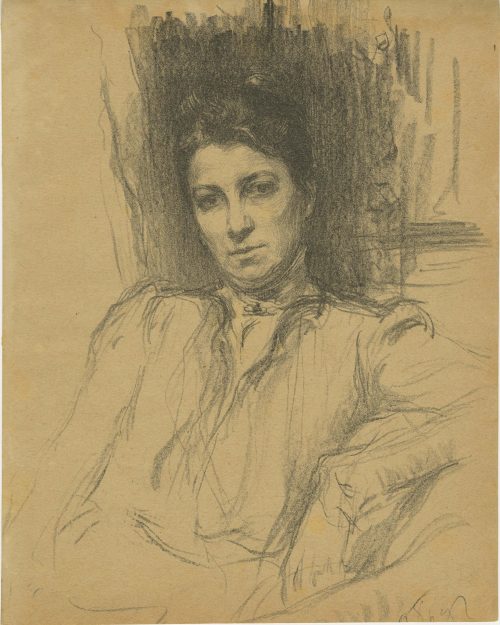
Portrait of Russian actress Maria Gavrilovna Savina, a lithograph on tan paper, by artist Osip Braz, 1900.
Maria Gavrilovna Savina (Мария Гавриловна Савина), a renowned Russian stage actress, born as Maria Podramentsova (Подраменцова) on April 11, 1854 in Kamianets-Podilskyi (Ukraine, Russian Empire) and died on September 21, 1915, in Saint Petersburg. Osip Emmanuilovich Braz (Осип Эммануилович Браз; 16 January 1873 in Odessa - 6 November 1936 near Paris) was a Russian painter of Jewish descent. Imprisoned by the Soviets in 1924 (the Solovki special prison-camp), released in 1926 and emigrated to Germany in 1928. Married to Lola Landshoff. http://russia-ic.com/people/culture_art/b/805/ "All his family members suffered from severe tuberculosis. After losing his wife Lola Lantsgof and both sons, he spent the last year of his life alone. Osip Braz passed away on November 6, 1936, and was laid down to rest at the Bagneux Cemetery in Paris." Buried at Bagneux, Hauts-de-Seine, Île-de-France, France.


